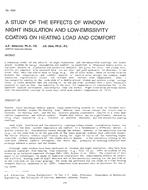-
-
Available Formats
- Options
- Availability
- Priced From ( in USD )
-
Available Formats
-
- Immediate download
- $16.00
- Add to Cart
Customers Who Bought This Also Bought
-

3037 -- Predicting Vibration and Noise Generated from Ref...
Priced From $16.00 -

3014 -- Evaluation of Numerical Methods for Ductwork and ...
Priced From $16.00 -

3016 -- Effects of the Natural Convection in a Partially ...
Priced From $16.00 -

3031 -- A Study of the Effects of Window Night Insulation...
Priced From $16.00
About This Item
Full Description
An experimental study concerned with different modes of heat transfer in fibrous and cellulose insulating material is presented. A series of experiments were conducted using an attic simulator to determine the effects of ventilation on attic heat transfer and the effect of infrared radiation on the thermal conductivity of insulation and on attic heat transfer. All the tests were performed at steady-state conditions by controlling the roof deck temperature. Tests were performed for insulation thicknesses between 1 in (25 mm) and 7 in (178 mm) and roof deck temperatures between 145 F (63 °C) and 100 F (36 °C).
The temperature profiles were measured by placing thermocouples at various levels within the insulation. The profiles for the cellulose insulation were linear. The profiles within the fibrous insulation were nonlinear due to the effect of infrared radiation. Heat fluxes were measured through different insulation thicknesses and for different roof temperatures. It was found that a radiant barrier such as aluminum foil can reduce the heat transfer from the roof to the attic floor by as much as 50%.
Experiments were also conducted when ventilating the attic by means of a fan. The hot side temperature of the fibrous insulation was reduced by 5 to 9 F (3 to 5 °C) with ventilation; however, the effects of infrared radiation were still dominant in fibrous insulation even with ventilation. Compared to the nonventilation case, the heat flux through the floor of the attic was reduced by about 16%.
Units: Dual






